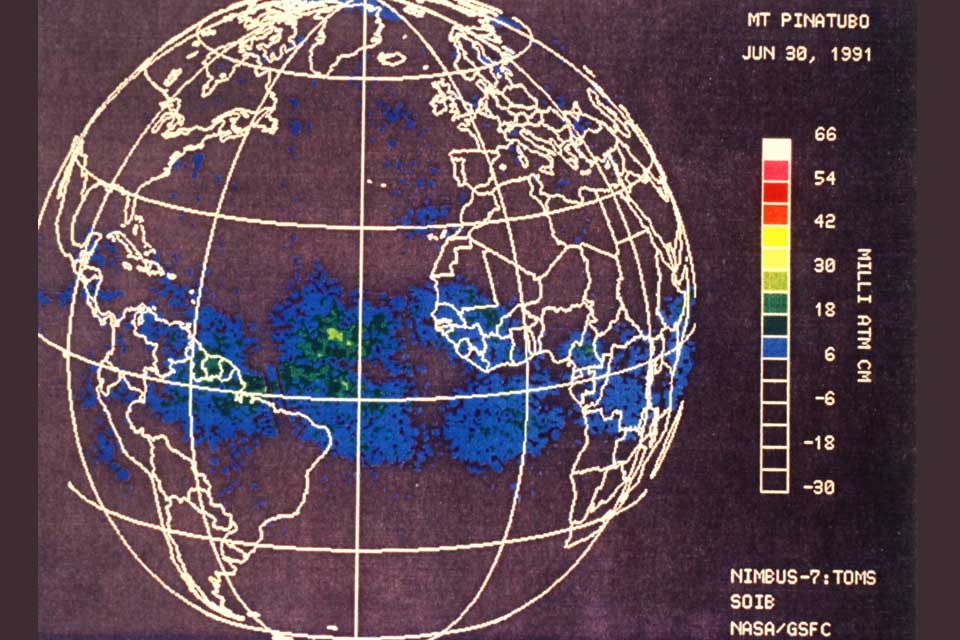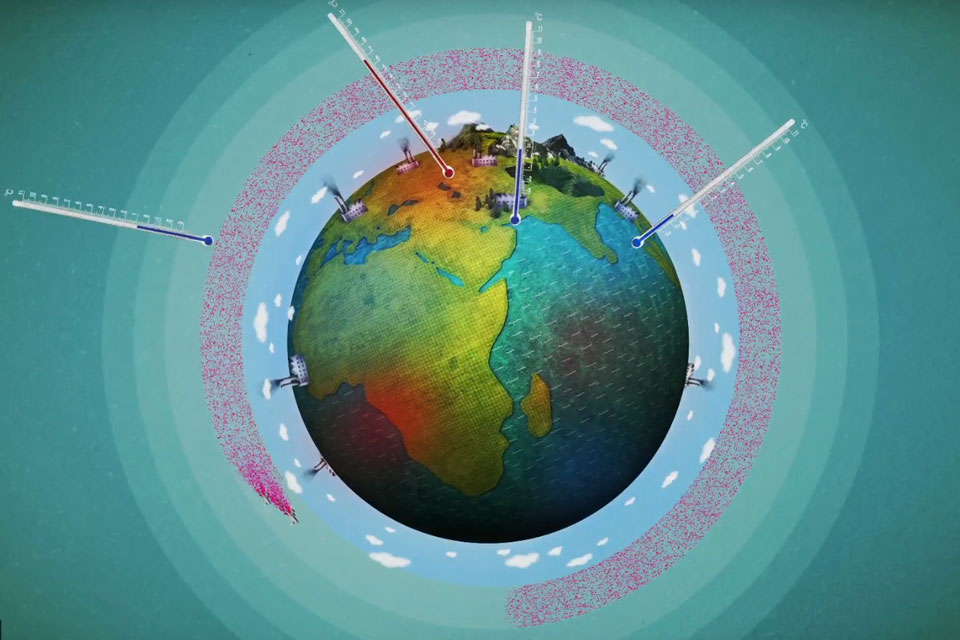Without governance mechanisms, some geoengineering technologies could pose a threat to international peace and security.

With climate change accelerating, there is increasing pressure to develop new technologies that could suck CO2 from the atmosphere or block the sun’s heat. Some of the technologies under discussion could have unpredictable effects that do not respect national boundaries. We also know that critical civilian infrastructure is commonly targeted in conflicts and that state and non-state actors have a long history of manipulating the environment for tactical advantage. With this in mind, Gabriela Kolpak examines whether the deployment of geoengineering technologies could create new threats to peace and to environmental security.
Introduction
Collateral environmental damage has long been regarded as an inevitable consequence of armed conflicts. But there have also been many examples of the intentional manipulation of the environment by warring parties, in which the environment becomes a weapon of war. This blog considers examples of environmental warfare such as scorched earth policies and the weaponisation of infrastructure, before examining how new technologies capable of modifying the environment could contribute to future security risks, or be instrumentalised in conflicts.
Scorched earth and environmental infrastructure
Scorched earth policies are military tactics aimed at destroying a given area and depriving it of anything of value to an opponent or civilians. This can include food, water, shelter, natural resources and critical civilian infrastructure. The Soviet Union employed this strategy in its withdrawal from Ukraine in WWII with the goal of slowing the German advance by rendering the region useless to the advancing forces. They would also come to deploy it in Afghanistan in the 1980s in an effort to subdue the Mujahideen. Cases of scorched earth policies continue to the present day, for example the Islamic State’s punitive devastation of agricultural areas in northern Iraq, and the oil fires and spills it caused.
Conflict parties often use their surroundings for military advantage. This includes the strategic use of environmental infrastructure such as water networks, and environmentally hazardous industrial facilities. Such weaponisation is commonplace and, as societies grow ever more dependent on environmental infrastructure for social and economic life, the consequences of its hostile use by warring parties grow ever more serious.
The weaponisation of water infrastructure provides one such example. Dams, pumping stations, treatment plants or pipelines may become the object of deliberate attack in order to subdue the civilian population. Alternatively, they may be captured and actively weaponised against an opponent. This weaponisation of water can take many forms, from diverting or disrupting water routes to flooding large areas of land, and impact both enemy forces and civilians alike. Environmental warfare of this sort has been witnessed in the Israeli-Palestinian conflict, with Israel’s intentional targeting of water pipelines and sewage systems in Gaza. Such destructive tactics have also proven particularly attractive to non-state armed actors.
Utilising the environment in conflict
That the environment is manipulated during armed conflicts is unsurprising. Historically, it has been pursued in a number of ways and for a variety of reasons, from weather modification to the physical alteration of natural landscapes. Outside of armed conflict, environmental modification is generally implemented to alleviate environmental risks or to improve access to natural resources. But as technology has advanced, so too has the ambition of belligerents.
This relationship was particularly apparent in the late 1960s and early 1970s, when Cold War superpowers were looking for new methods of warfare. Back then, military scientists were examining the potential for environmental modification techniques (EMTs) that could cause phenomena like earthquakes, tsunamis or cyclones; which could alter weather or climate patterns; or cause changes to ocean currents or to the different components of the atmosphere. There were many experts who were – and who remain – sceptical of the feasibility of some of the proposed EMTs. Yet contemporary asymmetric conflicts – involving a mix of state and non-state actors – are displaying a particular shift toward new and inventive methods of warfare. Against this backdrop, and with growing international disorder, and technological fixes for a rapidly changing climate on the table, could we see the re-emergence of EMTs as either a weapon or security threat? To answer this, it is first necessary to revisit the 1970s, when EMTs had a higher profile than today.
The ENMOD Convention
The Convention on the Prohibition of Military or Any Other Hostile Use of Environmental Modification Techniques, or ENMOD, entered into force in October 1978 with the following objective:
Each State Party to this Convention undertakes not to engage in military or any other hostile use of environmental modification techniques having widespread, long-lasting or severe effects as the means of destruction, damage or injury to any other State Party.1
ENMOD defines an EMT as ‘any technique for changing – through the deliberate manipulation of natural processes – the dynamics, composition or structure of the earth, including its biota, lithosphere, hydrosphere and atmosphere, or of outer space.’2
The ENMOD Convention, ‘the first and, so far, the only international treaty to specifically address means of methods of environmental warfare,’3 was approved in 1976 by UN General Assembly resolution 31/72 in response to international concern over the use of military tactics that could manipulate and damage the environment. Attention on the weaponisation of the environment had increased after the US’s use of weather modification techniques – cloud seeding – and Agent Orange herbicide in the Vietnam War; developments that coincided with, and encouraged, the birth of the modern environmental movement.
Proposed restrictions on EMTs because of their unforeseen environmental consequences, and the risk that even more destructive methods would be developed, emerged in the US Senate in 1972. The USSR unilaterally took the initiative two years later, proposing that a prohibition be added to the agenda of the UN General Assembly and introducing a draft convention. The move led to ENMOD’s development, forced the US to the table, and highlighted its destructive tactics in the conflict in Indochina.4
ENMOD provides a legal framework applicable only to situations of military or hostile use of EMTs, as clarified by Article III(1):
The provisions of this Convention shall not hinder the use of environmental modification techniques for peaceful purposes and shall be without prejudice to the generally recognized principles and applicable rules of international law concerning such use.5
The convention’s potential to become an effective tool in regulating the use of EMTs outside of armed conflict has been largely suppressed by the inclusion of this provision. Accordingly, the “hostile use” of EMTs has become associated only with military activities. The problem is that, while some EMTs may be employed for peaceful purposes, it cannot be guaranteed that their effects, which are often transboundary in nature, will not be perceived as hostile by other states. Such unintentionally hostile effects of EMTs highlight the loophole created by the ambiguous terms “hostile” and “peaceful”; something that ENMOD did not account for. This ambiguity has implications for the growing interest in EMTs for the purpose of addressing the intensifying climate crisis.
The wording of Article I of ENMOD also makes it unclear whether EMTs are prohibited in both international as well as non-international armed conflicts (NIACs). As pointed out by the International Law Commission (ILC) in its ongoing study on the Protection of the environment in relation to armed conflicts (PERAC), ENMOD specifies that the damage or injury caused by the hostile or military use of an EMT must be done to another “State Party”.6 It is therefore debatable whether ENMOD encompasses the use of EMTs in the NIACs that constitute the majority of contemporary armed conflicts.
The ILC addressed the use of EMTs for military or hostile purposes during its most recent session (April-August 2019), when it adopted, on first reading, 28 draft principles on PERAC, including draft principle 19 on EMTs:
In accordance with their international obligations, States shall not engage in military or any other hostile use of environmental modification techniques having widespread, long-lasting or severe effects as the means of destruction, damage or injury to any other State.7
Although draft principle 19 is specific to states only, the draft principles represent a significant development in international law as they place a newfound focus on the obligation of both state and non-state actors to protect the environment during armed hostilities. Nonetheless, these obligations are strictly limited to situations of armed conflict and so the use of EMTs for peaceful purposes is not considered.
The rise of geoengineering
The alarming pace of climate change, and of the emissions that fuel it, has encouraged consideration of technological fixes known as geoengineering. The 2011 Expert Meeting report of the Intergovernmental Panel on Climate Change (IPCC) defines geoengineering as ‘a broad set of methods and technologies that aim to deliberately alter the climate system in order to alleviate the impacts of climate change.’8
Geoengineering technologies (GTs) are generally placed into two categories: solar radiation management and carbon dioxide removal. Solar radiation management seeks ‘to offset the effects of increased greenhouse gas concentrations by reducing the amount of solar radiation absorbed by the Earth’. It involves techniques that aim to increase albedo (the amount of reflected sunlight) such as injecting sulphate aerosols into the stratosphere, injecting sea salt aerosols to brighten clouds and increase their reflectivity, brightening the Earth’s structures and surfaces, or installing solar deflector panels in space.9
Meanwhile, carbon dioxide removal aims ‘to address the cause of climate change by removing greenhouse gases from the atmosphere.’10 Various methods of carbon removal and sequestration have been proposed to reduce atmospheric CO2 levels. Amongst them are terrestrial methods like afforestation, and the enhancement of natural carbon sinks, biomass-based techniques and carbon capture and storage; maritime methods such as ocean fertilisation to increase oceanic carbon storage; and chemical techniques, both terrestrial and maritime, including direct air capture and enhanced chemical weathering.

Geoengineering as a security threat
There exist many uncertainties regarding the consequences – and possible risks – of implementing geoengineering solutions at scale. Once employed, their precise impact on natural systems, both regional and global, is unknown. As with the above examples of environmental infrastructure and EMTs, there is a risk that GTs will be utilised for hostile purposes. As tools valuable to society, they may become exposed to deliberate attacks in armed conflict. They could be weaponised – strategically manipulated or used to alter the environmental conditions in a given area – or held hostage. Smaller-scale GTs in particular, such as locally applied carbon removal projects, may be more prone to capture.
Another uncertainty involves the environmental security risks that might arise in third countries. The development and employment of locally relevant GTs will be expensive, most likely limiting the use of these technologies to wealthier state or non-state actors. Poorer countries might lack the financial means to participate, but may nonetheless be faced with their potentially harmful, transboundary consequences. Larger-scale climate change interventions can realistically only be developed and employed through a global coalition, but one potentially skewed towards the interests of its more privileged participants: a future example of climate injustice. It may also be difficult to achieve a consensus as some countries may benefit from climate change. It is during this phase of deliberation that there are bound to be the most obstacles.
For example, solar radiation management could alter weather patterns and potentially reduce the amount of useful radiation for plant health, human health and solar energy. These changes can be modelled through numerical modelling. It is possible these results may be used to design solutions which favour richer countries. And, depending on the forum and time-pressure, the voices of less powerful stakeholders may be lost. As such, the mere act of suggesting implementation of some of these solutions may create or heighten tensions between states. Another danger is that the simulations may be wrong – something that is quite possible given the difficulty in validating these models in the absence of observational data for these scenarios. In any case, if consensus is not reached, or if it is reached under duress, the consequences of implementing solar radiation management solutions may be perceived as acts of war, may contribute to existing conflicts or provoke new ones.
Initially peaceful, yet ultimately harmful geoengineering projects could exemplify the unintentional hostile use of EMTs discussed above. Yet, neither ENMOD nor the ILC’s draft principles take this form of use into account, so neither provides a viable tool for regulating their future use.
Increasing interest in GTs as a solution to global warming also risks states neglecting their commitments to reduce greenhouse gas emissions. With the wealthy having a tool to resist climate change – be it only temporarily – states might choose to abandon efforts to address the root causes of global warming.11 In this way, a focus on geoengineering solutions would not provide a cure for the global climate crisis, as some would like to believe, but would merely alleviate the symptoms of a flawed system centred around overconsumption, inequality and environmental injustice.

The current debate on geoengineering: regulation and responsibility
As potentially useful tools in countering climate change, GTs will require international consensus on how their use will be regulated. Some argue that existing instruments of international law could suffice in steering global geoengineering projects.12 And that the creation of new international laws for this purpose might not be necessary, as long as a proper regulatory framework is in place.13
As the effects of many GTs are likely to transcend state borders, there is much speculation about how they will be governed and by whom.14 But even the question of who should facilitate discussions on governance is contested. A resolution on GTs at the Fourth UN Environment Assembly in 2019 was blocked by the US, Saudi Arabia and Brazil after it sought to promote UNEP and its Assembly as a forum for governance discussions. The US argued that this should be the responsibility of the IPCC.
The resolution’s failure was unlikely to be solely due to disagreement on the appropriate forum for geoengineering discussions. It could also be explained by the many differing motivations of the actors involved; not only states, but also advocacy groups and private entities. One thing is certain: the regulation of carbon dioxide removal techniques versus solar radiation management are approached very differently, the latter being perceived as a riskier, more contested form of geoengineering, and with wider implications.
It therefore seems counterproductive to consider these two very different categories of GTs in proposals that merge them together – as the resolution did. The success of future geoengineering governance initiatives will likely depend on this crucial distinction between the two types of GTs. Despite its failure, the 2019 UNEA resolution has created the space for further discussions on governance. But it has also confirmed that the route to reaching an international consensus on such highly controversial technologies will not be an easy one.
Because the proposed GTs have yet to be empirically tested, the debate on their global governance is also applicable to geoengineering research and experimentation. This will certainly be the case for field tests that could cause effects on regional or international levels, crossing state borders and jurisdictions, with larger-scale tests requiring multi-level cooperation and international governance.
Of equal importance are issues of enforcement and responsibility. In their geoengineering activities, states will be restricted by their international legal obligations. However, states do not always adhere to international rules and their proper enforcement cannot be guaranteed. The issue is not solely that of state responsibility; geoengineering activities are also likely to involve private actors. Under existing international law, how could state and non-state actors alike be held accountable for geoengineering activities that result in transboundary environmental harm?
Conclusion
Climate change is creating threats to international peace and security. While GTs may present an increasingly attractive solution for some governments, their exploration and deployment would not be without risk. Once set in motion, could control over these complex and highly invasive technologies be maintained? And how would states or the international community respond to any unintended consequences that might arise from their use?
Before the point is reached where GTs can be deployed at scale, the international community would face a series of ethical, technical, security and governance questions that at present it seems ill-equipped to address. Similarly, the prospect of solutions that properly resolve fundamental concerns over environmental justice and intergenerational equity seem slim. But with an issue as urgent as a rapidly changing global climate, time truly is of the essence. Lacking a wholehearted commitment to climate change mitigation, the international community may eventually be compelled to give GTs serious consideration.
Historical examples of where the environment, and environmentally risky infrastructure, have been used as a weapon of war are commonplace. Therefore, the potential weaponisation of GTs cannot be dismissed out of hand, and any move to develop or deploy them must take these risks into account.
Gabriela Kolpak is a recent graduate from the University of Manchester with a MA in Security and International Law.
- ENMOD, Article I(1).
- ENMOD, Article II.
- ILC Commentary to the DPs, p 265, para 6.
- L. Juda, ‘Negotiating a treaty on environmental modification warfare: the convention on environmental warfare and its impact upon arms control negotiations’ (1979) International Organization 975.
- ENMOD, Article III(1).
- ILC Commentary to the DPs, p 264, para 3
- ILC DPs, Principle 19
- Intergovernmental Panel on Climate Change, ‘IPCC Expert Report Meeting on Geoengineering’ (Lima 20-22 June 2011) 2
- IPCC Report, 10
- IPCC Report, 10
- The Royal Society, ‘Geoengineering the climate: science, governance and uncertainty’ (September 2009) 37
- Amongst others the 1972 London Convention and Protocol, the 1992 UNFCC and 1997 Kyoto Protocol, the 1992 Convention on Biological Diversity, the 1982 UN Law of the Sea Convention, the 2015 Paris Agreement, international human rights regimes, as well as customary international law.
- The Royal Society, 39-41
- Ibid, 37-38





